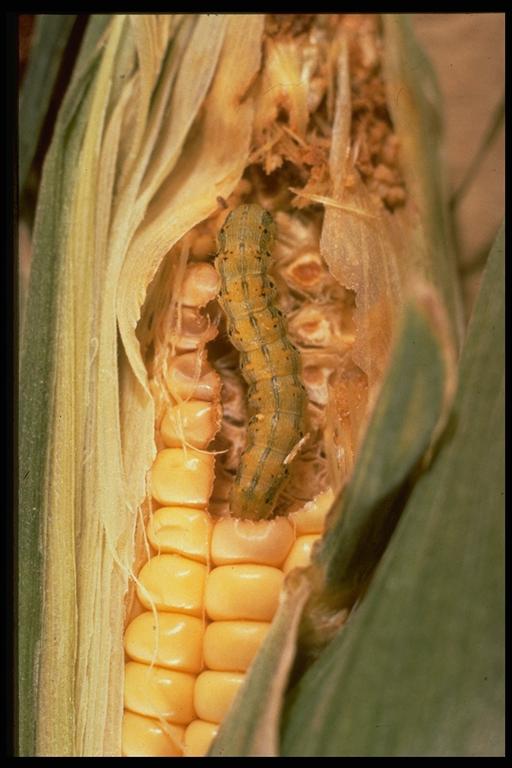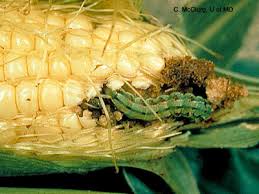Symptoms:
Feeding injury occurs at the tip and along the sides of the ear near the tip. Earworm larvae enter the ear primarily through the silk channel, unlike European corn borer and fall armyworm, which enter through the husks or cob. As silks dry, corn earworm begin chewing on individual and/or groups of kernels. When leaving the ear, corn earworm may drop from the ear tip or create exit holes by chewing through the husk. These exit holes can be mistaken for entrance holes caused by other larvae.
Cause:
Corn earworm (Heliothis zea)
Management:
Ear damage is not regarded as major problem in field corn in the U.S. Eastern Corn Belt . Control is only economically justified on seed, sweet, or popcorn. Treat if 10 or more moths for several consecutive nights are captured in an earworm pheromone trap just before or during silking (http://extension.entm.purdue.edu/publications/e-219.pdf). Many insecticides are labeled for earworm control. Bt transgenic hybrids are available that have resistance to earworm.
References:
Cook, K. 2005. Corn Earworm, European Corn Borer, Fall Armyworm, or Western Bean Cutworm: Which One Is Causing the Injury I’m Finding on My Corn Ears? The University of Illinois IPM The Bulletin No. 23 Article 4/October 7, 2005. Available at http://bulletin.ipm.illinois.edu/?p=3730 [URL verified 1/16/2019].
DiFonzo, C. 2018. Handy Bt Trait Table. Michigan State University. Available at https://aginsects.osu.edu/sites/aginsects/files/imce/BT%20Trait%20Table.pdf [URL verified 3/28/2019].
Kelly A. Cook and Rick Weinzier. 2004. Corn Earworm. University of Illinois Integrated Pest Management Insect Fact Sheet. Available at https://ipm.illinois.edu/fieldcrops/insects/corn_earworm.pdf [URL verified 3/28/2019].
Krupke, C.H., Obermeyer, J.L., and. Bledsoe, L.W. 2014. Corn Insect Control Recommendations – 2014. E-219-W. Dept. of Entomology. Purdue Extension. Available at http://extension.entm.purdue.edu/publications/e-219.pdf [URL verified 3/28/2019].

